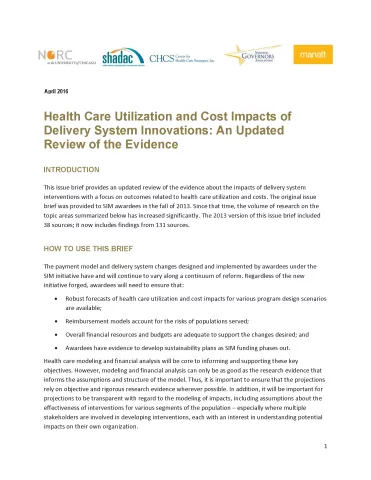Health Care Delivery Transformation: Evidence for Planning
In recent years, health care delivery transformation initiatives such as care management programs, patient-centered medical homes, accountable care organizations, and behavioral health integration programs have proliferated. Not surprisingly, there has also been a corresponding increase in the volume of research in this area.
Evidence from this research informs the assumptions and structure of delivery system and/or payment model development, helps planners anticipate the potential impacts of interventions, and facilitates stakeholder discussions about potential strategies and approaches. When designing and implementing a payment model or delivery system reform:
Planners should consider robust forecasts of health care utilization and cost impacts for various program design scenarios.
Reimbursement models should account for the risk profiles of populations served.
Overall financial resources should be adequate to support the changes desired.
Sustainability plans for the initiative should take findings from research evidence on sustainability into account.
Planners should take into consideration specific contextual factors (e.g., political environment, stakeholder buy-in and experience, budgetary constraints, etc.) when evaluating how factors associated with specific programs described in the literature are similar to or different from the environment where the innovation will take place.
New SHADAC Brief Summarizes the Research Evidence
A new SHADAC issue brief summarizes the existing research evidence on the cost and utilization impacts of a variety of delivery system innovations such as patient-centered medical homes (PCMH), accountable care organizations (ACO), care and case management interventions, behavioral health and primary care integration, disease management programs, and care continuity approaches.
A detailed Excel table accompanies the issue brief narrative and is sortable by type of intervention, care setting, disease/condition, payer, age, and study duration. The table includes descriptive information about the study population(s), study duration, and reported findings on: return on investment; cost impact of the intervention; and impacts on health care cost and utilization (including emergency department use; hospital admissions and readmissions or lengths of stay; use of primary and specialty care services; and the use of other services such as pharmacy and imaging studies).
Although quality was not a primary focus of our review, the detailed Excel table also includes information about quality outcomes when the study authors provided it.
This issue brief was produced by SHADAC with support from the Center for Medicare & Medicaid Innovation (the Innovation Center). SHADAC is part of a team led by NORC at the University of Chicago that serves as the State Innovation Models (SIM) Resource Support Contractor. SHADAC and other technical assistance partners support states and the Innovation Center in designing and testing multi-payer health system transformation approaches.

